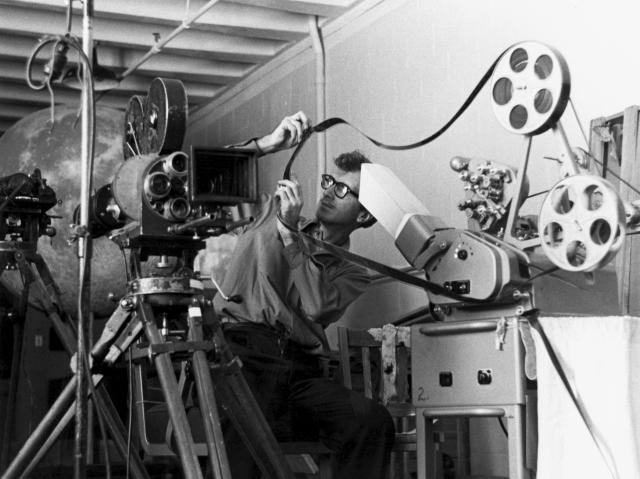Some edits are hardly noticeable, while others change movie history.
Film editing has come a long way since Robert W. Paul produced one of the first movies to include more than one shot in the 1898 movie Come Along, Do! No longer are editors restricted to using the same transitions repeatedly as in the 1903 movie Life of an American Fireman.
To think movie pioneers edited these classics using only a Moviola or their hands.

While video editing has progressed beyond rudimentary design thanks in part to NLEs like Adobe Premiere and Avid Media Composer, NewBlueFX honors the early film editors from the entirety of movie history who made the ingenious cuts that transformed the art of editing into the magic we see on the big screen today.
We present you with the top 10 edited sequences that shaped the history of movies and the revolutionary editors that made it all possible.
Top 10 Edited Sequences their Editors in Movie History!
1. Battleship Potemkin (1925)
Editors: Sergei Eisenstein and Grigori Aleksandrov
5:32
The Cut: Potempkin is a beautiful and highly effective piece of propaganda because of editors, Sergei Eisenstein and Grigori Aleksandrov use creative use of montage and emotion. Wanting the audience to empathize with the rebellious sailors, Eisenstein and Aleksandrov included highly emotional cuts of the Tsar’s soldiers firing into a crowd resulting in falling victims. Potempkin is renowned for the scene where a mother is shot down and her baby carriage crashes down the Odessa steps.
2. Citizen Kane (1941)
Editors: Robert Wise and Mark Robson
The Cut: Robert Wise and Mark Robson’s editing made Citizen Kane a critics choice for the best film ever. Some of the film cuts include a “lighting-mix” where a complex montage sequence is connected by related sounds, flashbacks, flash-forwards, and transitory dissolves. Though there are many famous scenes in this historic film, our favorite is when Mr. Kane sings “You buy a bag of peanuts in this town, you get a song written about you.” The scene took – at the time – advanced skill in mixing soundtracks together. Wise and Robson used several different elements of sound to create the impression of distance in voice.
3. Breathless (1960)
Editors: Cécile Decugis and Lila Herman
The Cut: The innovative editing technique of jump cuts, was first brought to the bigs screen by editors, Cécile Decugis and Lila Herman. The jump cut method was accounted by Assistant Director Pierre Rissient as unintentional and created out of dire need to shorten Breathless from two and a half hours down to ninety minutes. The use of jump cuts has remained highly controversial. Academy Award-winning editor, Walter Murch, said of the jump cut, “We accept the cut because it resembles the way images are juxtaposed in our dreams. In fact, the abruptness of the cut may be one of the key determinants in actually producing the similarity between films and dreams.”
4. Psycho (1960)
Editor: George Tomasini
The Cut: George Tomasini editing turned Alfred Hitchcock’s psychological thriller into a masterpiece, receiving four Academy Award nominations. The movie received abundant fame for the famous shower scene, a 45-second sequence that originated from editing 78 pieces of film. The cutting of the hand, parts of the torso, shadow on the shower curtain, and the shower itself, were all done with extreme precision.
5. Manchurian Candidate (1962)
Editor: Ferris Webster
The Cut: Ferris Webster received the 1962 Academy Award for Editing for this political thriller. Webster cuts back and forth between time and place in order to reveal shocking plot details and create tension throughout the film. The cuts between memories and nightmares provide an excellent look at what it takes to portray stark realism to the narrative.
6. Lawrence of Arabia (1962)
Editor: Anne V. Coates
The Cut: One of the best editors all-time, Anne V. Coates, was vital in propelling Lawrence of Arabia to seven Academy Awards including Best Sound Editing and Best Film Editing. Now that’s movie history.
The most famous cut of the film occurs in Dryden’s office before Lawrence goes to the desert. The shot starts as a close-up of Lawrence, then cuts to a Sahara sunrise. The sun emerges behind the desert horizon and the vast orange sand hints at the enormous landscape that Lawrence intends to conquer.
Want to know more about Coates editing process? Read this fantastic interview she gave on Laurence of Arabia.
7. The Birds (1963)
Editor: George Tomasini
The Cut: Once again film editor George Tomasini makes the list with another Hitchcock film, The Birds. The scene of the gas station attack is a perfect example of rhythm in editing. The cuts include multiple perspective and volume changes from inside the phone booth, inside the diner, and outside the gas station. In addition, the combination of the sound of running gasoline, shouts of people in the diner, sound of burning gasoline, Melanie screaming, the explosion, and the aerial shot mixed with wind noise, makes for one cataclysmic event.
8. Good, the Bad and the Ugly (1966)
Editors: Eugenio Alabiso and Nino Baragli
The Cut: Editors Eugenio Alabiso and Nino Baragli do an excellent job of conveying emotion and storyline in the Good, the Bad and the Ugly. This famous cut surrounds a decisive culmination stemming from the intensity of three cutthroat gunfighters. They square off against each other in a large circular cemetery, where the film cuts to close-ups of their faces to portraying critical emotions. Rumor throughout movie history has it that this scene was edited to the music instead of fitting the music to the film.
9. 2001: A Space Odyssey (1968)
Editor: Ray Lovejoy
The Cut: Editor Ray Lovejoy helped piece together this incredible film by using scene cuts to generate the curiosity and awe feelings that parallel outer space. To magnify one of the most remembered cuts throughout movie history, Lovejoy used a graphic match cut which involved cutting from one image to another without it graphically matching the previous. Specifically, the bone thrown by Ape provides a symbolic transition from the Neanderthal world to the future 2001 (now our past).
10. The Godfather (1972)
Editor: Barry Malkin
The Cut: In The Godfather, Barry Malkin edited one of the most powerful scenes in film history, the baptism scene. The famous baptism scene incorporated 67 pieces of film and a perfectly fitting organ track over the collection of shots. As Michael’s godson is baptized, the last 5 dons of New York are killed. The parallel editing, cutting from the baptism to the killings, perfectly depicts a symbolic connection between good and evil.
This wraps up our list of the ten best-edited movies and sequences from the entirety of movie history. Did you notice which editor made our list twice?
At NewBlueFX, we’re all about making life easier for the video editor. Check out some of the ways we do that at newbluefx.com.
